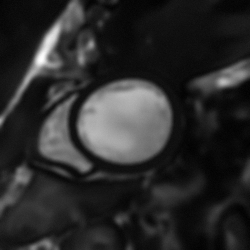Software
CMRsim - Simulating CMR of Moving Objects
CMRsim is a simulation framework that features full Bloch simulations as well as analytical signal evaluations for moving objects with an easy-to-use API in Python. The computationally demanding calculations are implemented in TensorFlow2 and can be executed in CPU and GPU environments alike.
What makes CMRsim special?
- Use of Bloch simulations as well as analytical signal equations
- Convenient support for moving particles.
- Architecture that allows including your own simulation modules with ease
- calable to detailed time-resolved digital phantoms
How to get started?
Check our GitLab.
Reference
Contact
Sebastian Kozerke (kozerke)
MRXCAT - Numerical CMR Phantoms

MRXCAT is a framework for numerical simulation of cardiac MR. It is based on the extended cardiac torso phantom (XCAT), which provides anatomical tissue masks and incorporates cardiac contraction and respiratory motion. MR properties such as tissue parameters, contrast and signal models, receive coils and noise are assigned in MATLAB.
MRXCAT is distributed in Matlab source code format to support reproducible research. Anyone is allowed to use MRXCAT original and/or modified software for non-commercial purposes. If you publish research using MRXCAT, please cite the MRXCAT publication.
How to get started?
Send us an
Reference
Contact
Sebastian Kozerke ()
MRXCAT 2.0 - Biophysical CMR Phantoms

MRXCAT 2.0 is an extension of the MRXCAT framework for cine images. It couples the extended cardiac torso phantom with an anatomical and a biophysical functional model of the left ventricle, enabling the simulation of both healthy and pathological cardiac function. MR tissue properties are assigned using a texturizer leading to realistic image appearance.
MRXCAT 2.0 is open source and anyone is allowed to use the original and/or modified software for non-commercial purposes. If you publish research using MRXCAT 2.0, please cite the MRXCAT 2.0 publication.
How to get started?
Check our GitLab.
Reference
Contact
Stefano Buoso ()
Essential Vision - Digital Organ Holographic Display

Essential Vision is an innovative HoloLens application to visualize digital twin organs derived from time-resolved medical imaging data. It allows to display complex, multi-layer organs and structures including overlays of functional features such as dynamic muscle fiber rearrangement, blood flow and many more.
- Conversion service to convert time series of .vtk files into HoloLens 2.0 asset bundles
- Interactive visualization of moving digital twin organs
- Multi-layer objects and annotations for education and teaching
- Shared experience to interact in teams and in classroom settings
How to get started?
Check our external page project website.
Contact
Sebastian Kozerke ()